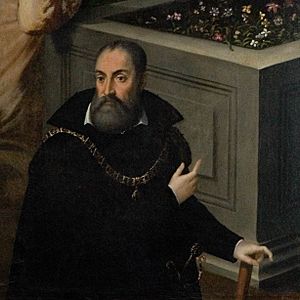Ferrante Gonzaga facts for kids
Ferrante I Gonzaga (also known as Ferdinando I Gonzaga) was an important Italian leader and soldier. He was born on January 28, 1507, and passed away on November 15, 1557. Ferrante was a member of the famous House of Gonzaga family. He also started a new part of the Gonzaga family in a place called Guastalla.
Ferrante's Life and Adventures
Ferrante was born in Mantua, Italy. He was the third son of Francesco II Gonzaga and Isabella d'Este. When he was sixteen, he went to Spain to work for Charles V, who would later become a powerful emperor. Ferrante stayed loyal to Charles V his whole life.
In 1527, Ferrante was part of a big event where the city of Rome was attacked. Later, in 1530, he attended Charles V's important crowning ceremony in Bologna. After Charles of Bourbon died in 1527, Ferrante became the main leader of the Emperor's army in Italy. In 1531, he became a special knight in an important group called the Order of the Golden Fleece.
Ferrante helped protect Naples from French soldiers. He also managed to get the city of Florence to give up. Because of this, Pope Clement VII made him the governor of Benevento. Ferrante continued to fight for Charles V. He fought against the Turks in Tunis in 1535 and in Algiers in 1541. He led a group of 3,000 horsemen in these battles.
Ferrante served as the Viceroy (a ruler representing the king) of Sicily from 1535 to 1546. A fort called Forte Gonzaga was named in his honor. He also went with the Emperor to Germany in 1543. There, he fought in a strong campaign that helped make the Treaty of Crépy happen. After that, he was the Governor of the Duchy of Milan from 1546 to 1554. In this role, he fought in the War of Parma.
In 1529, Ferrante married Isabella di Capua. She brought him control over lands like Molfetta and Giovinazzo. In 1539, he bought the area of Guastalla for a lot of money (22,280 golden scudi). Guastalla was important because it was near Ferrara, a city Charles V wanted to take from the House of Este family.
Ferrante had a villa near Milan called La Gualtiera, which is now known as La Simonetta. He had it rebuilt in the 1550s by an architect named Domenico Giuntallodi. Ferrante also supported artists like the sculptor Leone Leoni. Leoni made a bronze medal for Ferrante around 1555. Later, Ferrante's son, Cesare, asked Leone to create a larger bronze statue called Triumph of Ferrante Gonzaga over Envy. This statue can still be seen in Guastalla today. Like other members of the Gonzaga family, Ferrante also supported people who made tapestries. He had a series of tapestries called Fructus Belli (meaning "the Fruits of War") made for him in 1544.
Ferrante died in Brussels in 1557. He had a fall from a horse and was tired from fighting in the Battle of St. Quentin. He was buried in the sacristy of the Mantua Cathedral.
His son, Cesare, took over in Guastalla after him. Ferrante also served as an ambassador to Henry VIII of England in 1543.
Ferrante's Children
Ferrante and Isabella had 11 children:
- Anna (born 1531), who died young.
- Cesare (1533–1575), who became the count of Guastalla. He married Camilla Borromeo.
- Ippolita (1535–1563). She married Fabrizio Colonna in 1549 and Antonio Carafa in 1554.
- Francesco (1538–1566), who became a cardinal.
- Andrea (1539–1586), who was the first marquis of Specchia and Alessano.
- Gian Vincenzo (1540–1591), who also became a cardinal.
- Ercole (1545–1549).
- Ottavio (1543–1583), who was the Lord of Cercemaggiore and a Captain General of the Spanish Cavalry in Italy.
- Filippo, who died young.
- Geronima, who died young.
- Maria, who died young.
Images for kids
See also
 In Spanish: Ferrante I Gonzaga para niños
In Spanish: Ferrante I Gonzaga para niños



